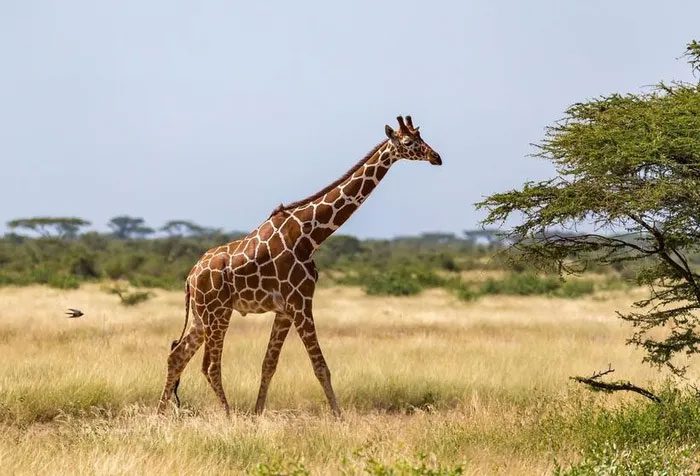Why Do Whales Have Gigantic Sizes? Why Do Turtles Have Shells or Giraffes Have Such Long Necks?
These remarkable features have evolved over time to help species adapt to life in the wild.
Turtle Shells
For many years, scientists have debated the evolutionary process behind turtle shells. According to a report published in the journal Current Biology, paleontologists once believed that the shell formed through the fusion of bony scales, similar to the bony plates on the back of crocodiles or armadillos.
However, developmental biologists disagreed with this theory as they observed that turtle embryos develop differently from those of crocodiles or armadillos. Instead, they believe that turtle shells evolved through the gradual expansion and fusion of ribs across the body.
The heated debate continued until 2008 when Chinese scientists discovered fossils of a turtle with a partial shell and teeth. Although the shell was incomplete, it lacked bony scales and had expanded ribs, confirming the theory proposed by developmental biologists. Scientists believe that the expansion of ribs was a transitional step in the evolution of turtle shells.
The Giraffe’s Neck

The giraffe’s neck evolved after battles with their counterparts.
The giraffe’s neck can reach lengths of up to 3 meters, allowing them to eat leaves from tall trees. However, the ancestors of modern giraffes did not possess this impressive neck.
Scientists have found fossils of Discokeryx xiezhi, a relative of modern giraffes, which lived about 17 million years ago. This species was smaller than modern giraffes, with a short neck and a thick, disc-shaped skull.
In 2022, scientists hypothesized that the thick skull of D. xiezhi evolved to withstand strong blows to the head during battles between males. After such fights, their necks lengthened to aid in combat.
The victorious males would pass this gene to their offspring, leading to the modern giraffe. Meanwhile, the defeated males may have died or failed to find mates. This hypothesis is known as “sexual selection of the neck.”
The Size of Whales
The blue whale is currently the largest animal on Earth. They evolved from the ancestor Pakicetus, which was only the size of a dog. According to a 2016 study published in the journal Biology Letters, the size of whales, including blue whales, has significantly increased over the past 5.3 million years.
One reason for this remarkable evolutionary leap is the foraging behavior of whales. To feed, whales move to areas rich in plankton, open their mouths, and suck in vast amounts of water and prey.
They then use bristle-like teeth to filter their food. This somewhat passive foraging strategy is linked to a highly efficient metabolic process, allowing whales to conserve a significant amount of energy while traveling long distances.
Scientists believe that in the past, the plankton supply, due to melting ice flowing into the oceans, was enormous and nutrient-rich. This abundant food source, combined with low energy expenditure, has driven the exponential growth of whales and allowed them to reach their current gigantic size.
Tiger Stripes

Stripes help tigers camouflage while hunting.
Tigers have unique stripes, much like human fingerprints. These stripes help tigers easily hide in the grass while hunting.
In 1952, British mathematician Alan Turing proposed a hypothesis that a chemical reaction between two different substances was the cause of these “patterns.” He referred to these substances as “morphogens,” which are found in the skin layers of tigers.
One type acts as an activator while the other acts as an inhibitor. The activator creates the stripes on the tiger, while the inhibitor forms the spaces between the stripes.
This hypothesis was confirmed in 2012 in the journal Nature Genetics.
Rattlesnake
The sound from a rattlesnake’s tail sends chills down the spine of anyone who hears it. According to a study in 2016 published in the journal The American Naturalist, scientists observed 56 snake species from the Viperidae family, including rattlesnakes, and Colubridae, one of the largest snake families.
When faced with a threat, snakes from both families begin to shake and rattle their tails, indicating that this behavior is common among snakes. The noise produced by a rattlesnake’s tail when shaken is due to two layers of keratin, the same material that makes up human nails, colliding at the tail’s end. Inside the tail, the hollow structure amplifies the sound, making it louder and more resonant.
The fastest tail-shaking snakes form a collective known as rattlesnakes, which are also the most evolved within the snake family.
Lobster Claws
Crustaceans similar to lobsters first appeared around 400 million years ago, but their claws developed significantly around 200 million years later. During this period, competition for food among marine predators intensified, requiring lobster claws to become larger and stronger.
Today, lobsters possess two large, sharp, robust claws, but their sizes are unequal. The larger one is the dominant claw, equipped with fast muscle fibers, capable of catching prey at a speed of 20 mm/second. The smaller one, while also sharp and sturdy, functions like a grinder to tear apart prey.
When first born, both claws of a lobster are the same size. However, they change in size over time to match how they are used.




















































